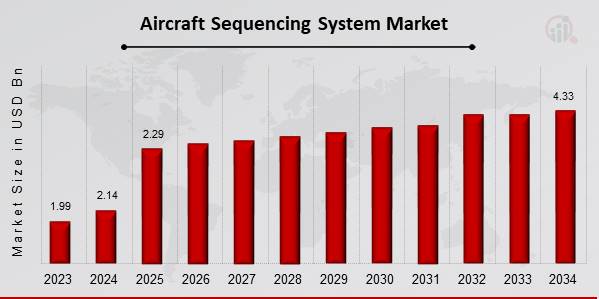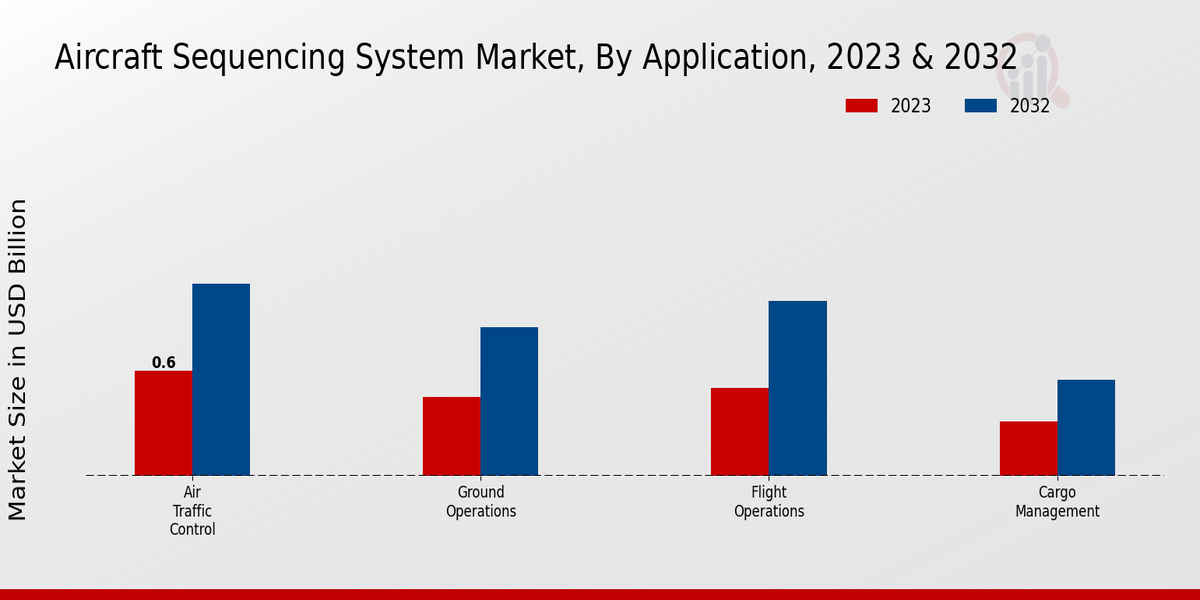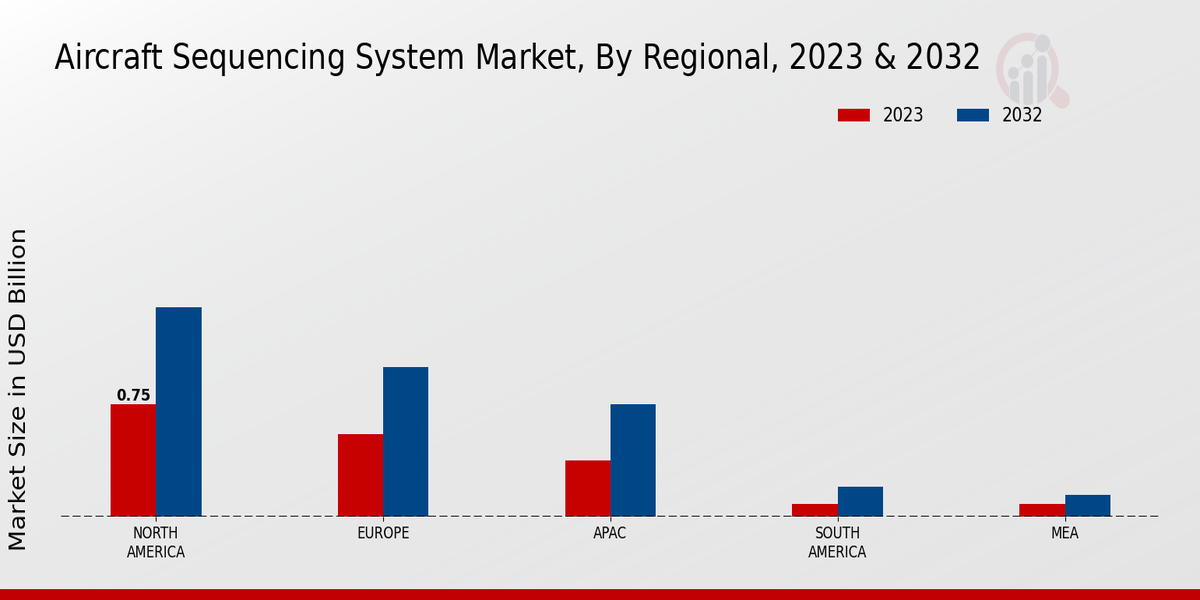Global Aircraft Sequencing System Market Overview
Aircraft Sequencing System Market Size was estimated at 2.14 (USD Billion) in 2024. The Aircraft Sequencing System Market Industry is expected to grow from 2.29 (USD Billion) in 2025 to 4.33 (USD Billion) by 2034. The Aircraft Sequencing System Market CAGR (growth rate) is expected to be around 7.3% during the forecast period (2025 - 2034).

Source Primary Research, Secondary Research, Market Research Future Database and Analyst Review
Key Aircraft Sequencing System Market Trends Highlighted
The aircraft sequencing system market is driven by the increasing demand for efficient airport operations and the growing need for improved air traffic management. As air travel continues to rise, airlines and airports are seeking solutions that can enhance the efficiency of aircraft movements, reduce delays, and optimize resource allocation. Additionally, technological advancements in automation and data analysis are empowering these systems to provide real-time information, allowing for better decision-making and operational efficiency. Opportunities in the market lie in the integration of advanced technologies such as artificial intelligence and machine learning.
These innovations can optimize flight scheduling, improve predictive maintenance, and enhance passenger experience through better management of boarding and deplaning processes. Airports are also exploring collaborative approaches, sharing data with airlines and air traffic controllers to streamline operations further. This cooperation can lead to more optimized flight paths and better utilization of airport infrastructure. In recent times, trends indicate a strong shift toward digitalization and the adoption of cloud-based solutions in the aircraft sequencing domain. Many airports are moving to real-time data-sharing platforms that facilitate communication among various stakeholders.
The focus is not only on improving time efficiency but also on enhancing safety and security measures. As the market continues to evolve, sustainability is becoming a significant concern, prompting the development of greener technologies and practices within the industry. The move towards more eco-friendly operations is shaping how aircraft sequencing systems are designed and implemented. Emphasizing efficiency, collaboration, and innovation presents a promising outlook for the future of the aircraft sequencing system market.
Aircraft Sequencing System Market Drivers
Increasing Demand for Efficient Aircraft Operations
The Aircraft Sequencing System Market Industry is experiencing significant growth, primarily driven by the increasing demand for efficient aircraft operations. As air travel continues to see robust recovery post-pandemic, airlines and airports are under pressure to enhance their operational efficiencies. This demand has led to the integration of advanced aircraft sequencing systems that optimize the flow of air traffic, minimize delays, and maximize resource utilization.
These systems allow for real-time data analysis and decision-making, ensuring that aircraft are sequenced in the most efficient manner to reduce waiting times on the tarmac and in the air. Moreover, the growing investments in airport infrastructure to accommodate larger aircraft and increasing passenger volumes further amplify the necessity for sophisticated sequencing solutions. As the Aircraft Sequencing System Market adapts to the evolving landscape, key players are continuously innovating to offer cutting-edge technologies that not only improve operational efficiency but also enhance safety and the overall passenger experience.
This trend is expected to continue, reinforcing the importance of aircraft sequencing systems in modern aviation operations.
Technological Advancements in Aviation
Technological advancements in aviation are a key driver for the growth of the Aircraft Sequencing System Market Industry. The incorporation of artificial intelligence, machine learning, and cloud-based technologies is transforming how aircraft operations are managed. Modern sequencing systems are now equipped with predictive analytics that can anticipate traffic congestion and optimize flight paths accordingly. These innovations translate to more efficient scheduling, fuel savings, and reduced operational costs.
As technology continues to evolve, the demand for more sophisticated and automated sequencing solutions is expected to rise, benefitting the entire aviation ecosystem.
Regulatory Support for Safety and Efficiency
Regulatory support for safety and operational efficiency is driving the Aircraft Sequencing System Market Industry. Governments and aviation authorities worldwide are emphasizing the importance of enhanced safety protocols and efficient air traffic management systems. This focus leads to increased funding and support for the development and implementation of advanced aircraft sequencing systems, promoting a safer and more efficient flying environment.
Compliance with new regulations often necessitates the adoption of modern sequencing solutions, thereby accelerating market growth.
Aircraft Sequencing System Market Segment Insights
Aircraft Sequencing System Market Application Insights
The Aircraft Sequencing System Market has exhibited robust growth within the Application segment, which encompasses various critical areas such as Air Traffic Control, Ground Operations, Flight Operations, and Cargo Management. In 2023, the overall market was valued at 1.86 USD Billion and is anticipated to reach 3.5 USD Billion by 2032, demonstrating the significant potential for market growth. Among the key applications, Air Traffic Control holds a majority share, with a valuation of 0.6 USD Billion in 2023 and expected to rise to 1.1 USD Billion by 2032.
This growth reflects the increasing need for efficient traffic management in congested airspace, which is vital for ensuring flight safety and optimizing aircraft movements. Ground Operations, valued at 0.45 USD Billion in 2023 and projected to grow to 0.85 USD Billion by 2032, also contributes significantly to operational efficiency by streamlining processes at airports, enhancing turnaround times, and improving overall service delivery.
Flight Operations, with a valuation of 0.5 USD Billion in 2023 and growth forecast to 1.0 USD Billion by 2032, ensures the management of flight schedules and procedures, facilitating a smoother flow of air traffic, which is crucial for maintaining punctuality and mitigating delays.
Cargo Management, while ranking lower with a valuation of 0.31 USD Billion in 2023 and set to increase to 0.55 USD Billion by 2032, plays an important role in logistics by overseeing cargo handling and transportation, underscoring the growth of air freight services. The diverse applications within the Aircraft Sequencing System Market highlight the intricate interplay of technology and operations across the aviation industry, driven by advancements in air traffic management solutions and the growing demand for optimized operations.
Growing air travel and increasing cargo shipments are fueling demand, while challenges such as regulatory compliance and the need for integration with legacy systems present opportunities for innovation and development in this sector.
The Aircraft Sequencing System Market statistics indicate a promising future as technological trends advance, enhancing capabilities across all applications and reinforcing the importance of the Application segment within the broader market landscape.

Source Primary Research, Secondary Research, Market Research Future Database and Analyst Review
Aircraft Sequencing System Market System Type Insights
The Aircraft Sequencing System Market is projected to experience substantial growth, focusing particularly on the System Type segment. Within this segment, Software-Based Systems play a critical role, as they offer flexibility and ease of integration into existing technologies, significantly improving workflow and decision-making processes. Hardware-based systems also hold importance, usually favored for their robustness and reliability in complex operational environments.
Meanwhile, Hybrid Systems offer a balanced approach, combining the strengths of both software and hardware, catering to various operational requirements in the aviation industry. The diversity within the Aircraft Sequencing System Market segmentation supports its resilience against market fluctuations, providing opportunities for innovation and improvement driven by advancing technologies. Factors such as increased air traffic, the need for improved turnaround times, and demand for more efficient resource management contribute to market growth.
However, challenges, including high initial investment costs and the complexity of system integration, may impact adoption rates. Overall, the Aircraft Sequencing System Market data reflects a dynamic landscape with significant opportunities and growth trajectories in the future.
Aircraft Sequencing System Market End Use Insights
The Aircraft Sequencing System Market is set to witness significant growth within the End Use segment, encompassing commercial aviation, military aviation and cargo aviation. The majority of the market demand is driven by commercial aviation, which plays a crucial role in enhancing operational efficiency and safety in air traffic management. Military aviation followed closely, focusing on the unique requirements of defense operations, where precision and reliability are paramount.
Cargo aviation, although smaller in scope, is gaining traction due to the increasing e-commerce trade and demand for swift logistics solutions. The market growth is supported by technological advancements and the rising need for improved aeronautical operations, while challenges such as high implementation costs and regulatory hurdles persist. As the Aircraft Sequencing System Market data evolves, the statistics reflect a trend towards digitization and automation, boosting the industry's operational capacity and paving the way for future opportunities in enhanced aircraft management systems.
Aircraft Sequencing System Market Functionality Insights
This segment encompasses various essential components, including Real-Time Sequencing, Data Management, Communication Systems and Monitoring Systems. Real-time sequencing has emerged as a crucial factor for streamlining aircraft operations, enhancing efficiency while minimizing delays. Data Management plays a significant role in ensuring accurate control of information throughout the sequencing process, further driving the overall market growth.
Additionally, Communication Systems facilitate seamless interactions between different aviation entities, promoting coordination and safety. Monitoring Systems are important as they help in the continuous assessment of operations, thus contributing to improved decision-making. The combination of these functionalities not only enhances operational efficiency but also addresses challenges in air traffic management, making the Aircraft Sequencing System Market industry more resilient and responsive to future demands. The anticipated upward trajectory in market growth is supported by advancements in technology, regulatory support and rising air travel demand.
Aircraft Sequencing System Market Regional Insights
The Aircraft Sequencing System Market is experiencing notable growth across various regional segments. Europe follows, valued at 0.55 USD Billion, where regulatory advancements and environmental concerns drive market enhancement. APAC, with a valuation of 0.38 USD Billion in 2023, showcases significant growth potential due to increasing air travel and investments in aerospace technology.
South America and MEA, while smaller in size at 0.09 USD Billion and 0.09 USD Billion, respectively, indicate an emerging market with opportunities for expansion as local airlines modernize their operations. The overall market growth is fueled by factors such as increasing air traffic, demand for efficiency, and the need for improved scheduling systems, which offer a chance for innovations and advancements in the Aircraft Sequencing System Market industry. As regions adapt to changing technological and market landscapes, their respective contribution and growth can leverage their unique advantages, driving further momentum in the market.

Source Primary Research, Secondary Research, Market Research Future Database and Analyst Review
Aircraft Sequencing System Market Key Players and Competitive Insights
The Aircraft Sequencing System Market has become a focal point of innovation and efficiency in the aviation industry, driven by the increasing demand for streamlined operations and enhanced safety features. Companies are continuously investing in research and development to improve aircraft sequencing systems, reflecting a broader trend of technological advancement in aviation. The competitive landscape is characterized by both established players and emerging companies, all striving to leverage cutting-edge technologies such as artificial intelligence, big data analytics, and advanced software solutions to optimize flight operations.
As the market develops, companies are also focusing on forming strategic alliances and partnerships to expand their market reach and bolster their product offerings.
Rockwell Collins has established itself as a significant player in the Aircraft Sequencing System Market, with an extensive portfolio of technologically advanced systems and solutions that enhance operational efficiency. The company excels in providing robust and reliable avionics and communication systems that facilitate efficient aircraft sequencing and management. Rockwell Collins benefits from its strong reputation for quality and reliability in the aerospace sector, fueled by a long track record of delivering high-performance products. The company’s innovative approach to integrating advanced technologies within its aircraft sequencing systems allows it to maintain a competitive edge.
Moreover, Rockwell Collins has a substantial presence, enabling it to cater to a diverse clientele and strengthen its influence in various regional markets.
ScioTeq is also making its mark in the Aircraft Sequencing System Market, focusing on next-generation display systems and mission-critical applications tailored to aviation requirements. The company leverages cutting-edge technology to enhance situational awareness and flight management through its aircraft sequencing solutions. ScioTeq’s strengths lie in its ability to offer customizable solutions that meet specific operational needs, along with its commitment to delivering high-quality, reliable products. The company's emphasis on user-friendly interfaces and integration capabilities allows for seamless incorporation of its systems into existing aircraft architectures.
ScioTeq’s dedication to innovation, along with its strategic partnerships and collaborations within the industry, positions it favorably to expand its market share and drive growth in this competitive landscape.
Key Companies in the Aircraft Sequencing System Market Include
Aircraft Sequencing System Market Industry Developments
-
Q2 2024: L3Harris Technologies Awarded FAA Contract to Enhance Air Traffic Sequencing at Major U.S. Airports L3Harris Technologies announced it was awarded a contract by the Federal Aviation Administration (FAA) to deploy its next-generation aircraft sequencing system at several major U.S. airports, aiming to improve runway throughput and reduce delays.
-
Q2 2024: Thales Launches Advanced Arrival Manager (AMAN) for European Airspace Thales introduced its new Arrival Manager (AMAN) solution, designed to optimize aircraft sequencing and reduce congestion in European airspace, with initial deployment at a major European hub.
-
Q3 2024: Collins Aerospace Unveils Next-Gen Aircraft Sequencing Platform at Farnborough Airshow Collins Aerospace launched its latest aircraft sequencing platform, featuring AI-driven decision support, at the 2024 Farnborough International Airshow, targeting global airport operators.
-
Q3 2024: PASSUR Aerospace Announces Strategic Partnership with NAV CANADA for Sequencing System Deployment PASSUR Aerospace entered a partnership with NAV CANADA to deploy its aircraft sequencing technology across select Canadian airports, aiming to enhance air traffic flow management.
-
Q4 2024: Indra Wins Contract to Supply Automated Sequencing Systems for Middle East Mega-Airport Indra secured a contract to deliver automated aircraft sequencing systems for a new mega-airport in the Middle East, supporting efficient runway operations and future traffic growth.
-
Q1 2025: Honeywell Debuts Cloud-Based Aircraft Sequencing Solution for Regional Airports Honeywell launched a cloud-based aircraft sequencing system tailored for regional airports, enabling real-time optimization of arrivals and departures with minimal infrastructure investment.
-
Q1 2025: SESAR Validates AI-Driven Aircraft Sequencing Tool in Live European Trials The SESAR Joint Undertaking completed live trials of an AI-powered aircraft sequencing tool at two major European airports, demonstrating significant reductions in taxi times and fuel burn.
-
Q2 2025: Raytheon Technologies Secures FAA Approval for NextGen Sequencing System Raytheon Technologies received FAA approval for its NextGen aircraft sequencing system, paving the way for deployment at U.S. airports as part of the national airspace modernization program.
-
Q2 2025: Leonardo Delivers Integrated Sequencing and Flow Management Suite to Italian Air Navigation Service Provider Leonardo completed delivery of its integrated sequencing and flow management suite to ENAV, Italy’s air navigation service provider, enhancing efficiency at key Italian airports.
-
Q2 2025: Frequentis Partners with Australian ANSP for Digital Sequencing Rollout Frequentis announced a partnership with Airservices Australia to implement digital aircraft sequencing systems at major Australian airports, supporting the country’s airspace modernization efforts.
Aircraft Sequencing System Market Segmentation Insights
Aircraft Sequencing System Market Application Outlook
Aircraft Sequencing System Market System Type Outlook
Aircraft Sequencing System Market End Use Outlook
Aircraft Sequencing System Market Functionality Outlook
Aircraft Sequencing System Market Regional Outlook
| Report Attribute/Metric |
Details |
| Market Size 2024 |
2.14(USD Billion) |
| Market Size 2025 |
2.29 (USD Billion) |
| Market Size 2034 |
4.33(USD Billion) |
| Compound Annual Growth Rate (CAGR) |
7.3% (2025 - 2034) |
| Report Coverage |
Revenue Forecast, Competitive Landscape, Growth Factors, and Trends |
| Base Year |
2024 |
| Market Forecast Period |
2025 - 2034 |
| Historical Data |
2021 - 2024 |
| Market Forecast Units |
USD Billion |
| Key Companies Profiled |
Rockwell Collins, ScioTeq, Lufthansa Systems, Honeywell, Amadeus IT Group, Airbus, Saab, General Electric, Collins Aerospace, Indra Sistemas, SITA, Thales, Siemens, Boeing, Northrop Grumman |
| Segments Covered |
Application, System Type, End Use, Functionality, Regional |
| Key Market Opportunities |
Increased air travel demand, Advanced automation technologies, Growing airport modernization projects, Rising focus on operational efficiency, Integration with AI and IoT |
| Key Market Dynamics |
Increasing air traffic demand, Technological advancements in automation, Enhanced safety and efficiency measures, Regulatory compliance pressures, Growing competition among airlines |
| Countries Covered |
North America, Europe, APAC, South America, MEA |
Frequently Asked Questions (FAQ):
The Aircraft Sequencing System Market was expected to be valued at 4.33 USD Billion in 2034.
The expected CAGR for the Aircraft Sequencing System Market from 2025 to 2032 is 7.3%.
North America is projected to have the largest market size, valued at 1.4 USD Billion in 2034.
The market size for the Air Traffic Control application is expected to reach 1.1 USD Billion in 2034.
Major players in the market include Rockwell Collins, Honeywell, Thales, and Boeing among others.
The Ground Operations application market is expected to be valued at 0.85 USD Billion in 2032.
In 2023, the Aircraft Sequencing System Market is valued at 1.86 USD Billion.
The Cargo Management application market is forecasted to reach 0.55 USD Billion in 2034.
The APAC region is expected to reach a market size of 0.75 USD Billion by 2034.
The market faces challenges such as technological integration and regulatory compliance impacting growth.

















